
Escort master cyls and circuit layout...
jmbillings - 30/11/04 at 09:23 AM
When we had our xflow in, our brakes were crappy (no leverage) but even. Since changing engine and pedal arrangement so the piston is connected more
in the proper place on the pedal, the car pulled left under braking. We decided it was probably the master cylinder (we checked corner weights,
caliper seals, got new rear cylinders etc etc) so we changed this over last night. Now, it pulls right!
After chatting to others it seems westfields have a front/rear circuit, and so did the escort, but we have a daigonal split. Is it possible that Mk2
master cylinders have a "strong" and "weak" split on the two sections and that the new one we have is the opposite of the
original? We are going to check this by swapping the pipes over at the master cyl end and see if the pulling swaps sides, that would confirm it, but
anyone know for sure? The new one is slightly different to the old one in that the part that fits through the bulkhead was about 5mm larger diameter,
and the last 3 or so digits on the long girling part code are different.
JAG - 30/11/04 at 09:29 AM
Both circuits operate at the same pressure.
By all means swap the pipes over to confirm this for yourself but it doesn't make any difference.
Have you know converted to a front/rear split? That's the norm on cars of this type.
jmbillings - 30/11/04 at 09:32 AM
We haven't converted to front/rear yet - if what you say is true about them operating at same pressure then it won't help, but we'll be
a bit stumped!
JAG - 30/11/04 at 11:36 AM
Main reason for the 'split' choice is to ensure adequate and controllable braking if you get a half system failure i.e a leak at one brake
etc...
If you have an X-split then the car will pull either left or right under decel' with a half system failure. If you use a front/rear split the car
won't pull (because both brakes on the same axle will be operating, either front or rear).
The level of decel' available won't vary much with either split because of the good weight distribution associated with these cars. But
front/rear will be more controllable 
britishtrident - 1/12/04 at 11:43 AM
For some reason diagonal split systems on very light cars are prone to this it used to be quite common on late 70s 1275GT Minis and Midgets with a
digonal split , it usually appeared after the pads reached 50% wear --- I found no explantion for it but I know how we fixed it --- Remove the
pads and carefully pump each caliper piston out a few mm then push them right back and fit new pads. Perhaps pushing back the pistons somehow
recentralised the master cylinder pistons.
Of course the long term cure is to go for a front rear hydraulic split.
JAG - 1/12/04 at 01:38 PM
Have you cleaned and re-greased the drumbrake backplate to shoe contact areas?
If you have a sticky rear drumbrake mechanism this could cause this problem. As could badly adjusted rear drumbrakes.
The drumbrakes have a much higher threshold pressure (hydraulic pressure needed to generate brake force) than the calipers.
Your system has one drumbrake and one caliper on each circuit. If one of the drumbrakes is seized/unadjusted this would cause the problem you
describe.
Dick Axtell - 2/12/04 at 06:04 PM
quote:
Originally posted by jmbillings
We haven't converted to front/rear yet
Why not?? Please be aware that Cortina front suspension assy was never intended/designed for X-split braking system.
Reason is very simple, and shown in this diagram.
Pivot radius (aka Ground offset) definitely a feature of the Cortina upright. If you use X-split system, there could be up to 5bar press differential
between the circuits (due to mcyl internal springs).
Under braking, steer torque is generated, due to the pivot rad. For this reason, change to F/R split.
Lol


Rescued attachment PivotRad.gif



